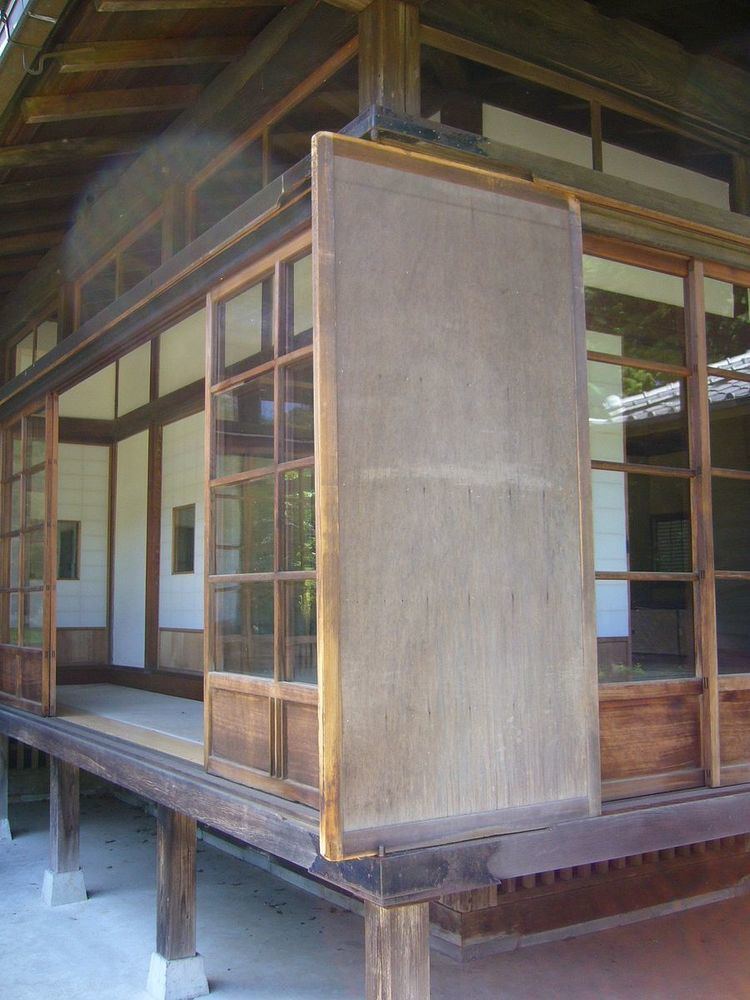 | ||
A storm door is a type of door that is installed in front of an exterior access door to protect it from bad weather and allow ventilation. Storm doors generally have interchangeable glass panels and window screen panels to provide visibility and prevent flying insects from entering the home.
Contents
Construction
Storm doors are typically made from wood, aluminum and plastics such as vinyl (PVC) and fiberglass. There are three basic types of storm doors: Full-View, Retractable Screen, and Ventilating.
Full-View storm doors typically include a full glass panel and most an interchangeable full screen.
Retractable Screen storm doors feature a screen that is rolled up into the frame of the storm door when not in use.
Ventilating storm doors generally include a full or half screen that is always in position on the storm door.
Wood
Wood was the original material from which storm doors were made. While wooden screen doors can be visually the most appealing, the wood itself requires painting or some other form of coating to protect it from the weather. Wooden screen doors less than one inch thick are used primarily as screen doors with no glass installed. Using wood thicker than one inch allows the storm door frame to accommodate glass panels. The door also becomes more rigid and durable as the thickness increases.
Aluminum
The main advantage of aluminum over wood as a storm door material is aluminum’s corrosion resistance. Aluminum storm doors do not need to be painted frequently to protect them from the elements. Aluminum storm doors are available in a variety of thicknesses. All of these thicknesses can accommodate interchangeable glass and screen panels.
The least expensive storm doors are the thinnest. As the storm door frame gets thicker, the door frame becomes more rigid. The strength and rigidity of the door is limited however, by the relatively brittle aluminum alloy corners that hold the frame together. If the door gets blown open during a storm, the corners can crack and the door will lose its strength. The corners however, can be replaced if parts can be found.
PVC and fibreglass
Materials such as PVC and fibreglass offer the most corrosion resistance of all when used in a storm door. They can also be moulded in such a way as to realistically mimic wood grain to provide the appearance of a wooden storm door. PVC or “vinyl” storm doors often require internal steel frames to provide the necessary strength to the door. However, extruded PVC doors offer extraordinary strength.
PVC is a controversial material in that during its production, useful life and incineration, especially in accidental and uncontrolled circumstances, it may liberate persistent toxins (see PVC Health and Safety section).
Fibreglass storm door frames are extremely strong, but the material is more expensive. Both PVC and fibreglass storm doors incorporate chemicals to slow the effects of ultraviolet radiation from the sun. UV radiation tends to make plastics become brittle. Again thicker doors have an advantage.
New technology has made extruded PVC doors more durable. This product is not likely to yellow, peel, crack, contract, expand or warp. Since it is made of PVC, this product does not need any painting even if scratched.
PVC doors are welded at the corners, and it is impossible for them to fall apart, separate or go out of square. The welding makes them extremely hard and durable. Because of the welding, there are no screws that will create wear and tear and separation at the corners.
Types of storm doors
Storm doors come in three different styles:
